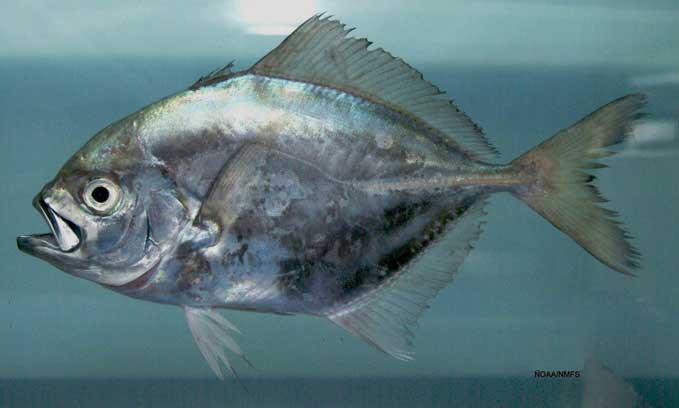
Uraspis secunda (SEFSC Pascagoula Laboratory; Collection of Brandi Noble, NOAA/NMFS/SEFSC )
Superregnum : Eukaryota
Regnum: Animalia
Subregnum: Eumetazoa
Cladus: Bilateria
Cladus: Nephrozoa
Superphylum: Deuterostomia
Phylum: Chordata
Cladus: Craniata
Subphylum: Vertebrata
Infraphylum: Gnathostomata
Megaclassis: Osteichthyes
Superclassis/Classis: Actinopterygii
Classis/Subclassis: Actinopteri
Subclassis/Infraclassis: Neopterygii
Infraclassis: Teleostei
Megacohors: Osteoglossocephalai
Supercohors: Clupeocephala
Cohors: Euteleosteomorpha
Subcohors: Neoteleostei
Infracohors: Eurypterygia
Sectio: Ctenosquamata
Subsectio: Acanthomorphata
Divisio/Superordo: Acanthopterygii
Subdivisio: Percomorphaceae
Series: Eupercaria
Ordo: Perciformes
Subordo: Percoidei
Superfamilia: Percoidea
Familia: Carangidae
Genus: Uraspis
Species: Uraspis secunda
The cottonmouth jack (Uraspis secunda) is a gamefish in the family Carangidae. It was first described in 1860 by Cuban zoologist Felipe Poey in his two-volume work Historia Natural de la Isla de Cuba, or "Natural History of the Island of Cuba". It is also known as the cottonmouth trevally.
Description
Adult cottonmouth jack are usually dark in color, while juveniles are pale with six or seven brown, vertical bars along their sides.[3] They are named "cottonmouth" because they are distinguished from other members of their family by their bleach-white mouth and tongue.[4] The cottonmouth jack's dorsal fin has a total of nine spines and twenty seven to thirty two soft rays. The anal fin has only three spines and nineteen to twenty three soft rays.[3]
The longest known cottonmouth jack measured 50 cm [5] and the greatest published weight was 2.04 kg.[6]
Distribution and habitat
The cottonmouth jack is pelagic and found throughout many oceans[7] at depths from 1 to 36 m (3.3 to 118.1 ft).[2] In the Western Indian Ocean, they are found off the coast of Tanzania,[8][9] in the Eastern Pacific Ocean, they are known from California to Costa Rica[10] and Hawaii.[2] In the western Atlantic, cottonmouth jack are found off Massachusetts to Brazil. They are also known from the northern Gulf of Mexico.[2] In the eastern Atlantic, Cottonmouth jack are known from Mauritania to Angola[11] and have also been found off the western coast of South Africa[3]
Cottonmouth jack usually swim throughout the water column but they are occasionally seen feeding on the bottom near islands. They do not live in large numbers and are usually seen as individuals or in small schools.[12]
A Cottonmouth jack caught off Key West.
Another from off the coast of Sri Lanka.
From the waters near Fiji.
Notes
Smith-Vaniz, W.F.; Williams, J.T.; Pina Amargos, F.; Curtis, M. & Brown, J. (2017) [errata version of 2015 assessment]. "Uraspis secunda". IUCN Red List of Threatened Species. 2015: e.T16507729A115360577. doi:10.2305/IUCN.UK.2015-4.RLTS.T16507729A16510417.en.
Froese, Rainer; Pauly, Daniel (eds.) (2019). "Uraspis secunda" in FishBase. August 2019 version.
Smith-Vaniz, W.F., 1986. Carangidae. p. 638-661. In M.M. Smith and P.C. Heemstra (eds.) Smiths' sea fishes. Springer-Verlag, Berlin.
"amonline.net.au". Archived from the original on 2008-03-15. Retrieved 2008-02-20.
Robins, C.R. and G.C. Ray, 1986. A field guide to Atlantic coast fishes of North America. Houghton Mifflin Company, Boston, U.S.A. 354 p.
GFA, 2001. Database of IGFA angling records until 2001. IGFA, Fort Lauderdale, USA.
Riede, K., 2004. Global register of migratory species - from global to regional scales. Final Report of the R&D-Projekt 808 05 081. Federal Agency for Nature Conservation, Bonn, Germany. 329 p.[clarification needed]
Smith-Vaniz, W.F., 1984. Carangidae. In W. Fischer and G. Bianchi (eds.) FAO species identification sheets for fishery purposes. Western Indian Ocean fishing area 51. Vol. 1. [pag. var.]. FAO, Rome.
Smith-Vaniz, W.F., 1986. Carangidae. pp.638-661. In M.M. Smith and P.C. Heemstra (eds.) Smiths' sea fishes. Springer-Verlag, Berlin.
Eschmeyer, W.N., E.S. Herald and H. Hammann, 1983. A field guide to Pacific coast fishes of North America. Houghton Mifflin Company, Boston, U.S.A. 336 p.[clarification needed]
Smith-Vaniz, W.F., J.C. Quéro and M. Desoutter, 1990. Carangidae. p. 729-755. In J.C. Quero, J.C. Hureau, C. Karrer, A. Post and L. Saldanha (eds.) Check-list of the fishes of the eastern tropical Atlantic (CLOFETA). JNICT, Lisbon; SEI, Paris; and UNESCO, Paris. Vol. 2.
Eschmeyer, W.N., E.S. Herald and H. Hammann, 1983. A field guide to Pacific coast fishes of North America. Houghton Mifflin Company, Boston, U.S.A. 336 p.
Retrieved from "http://en.wikipedia.org/"
All text is available under the terms of the GNU Free Documentation License

